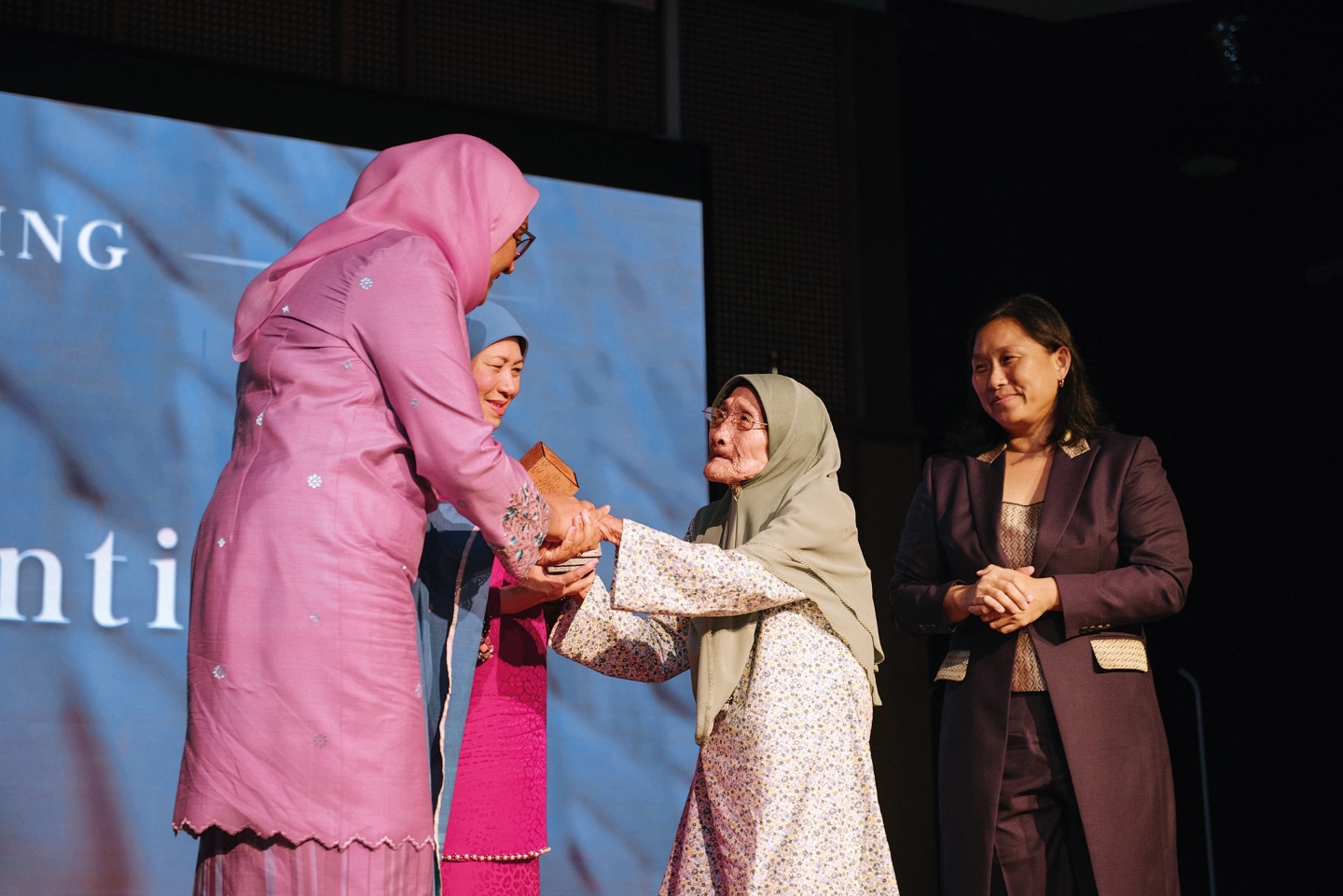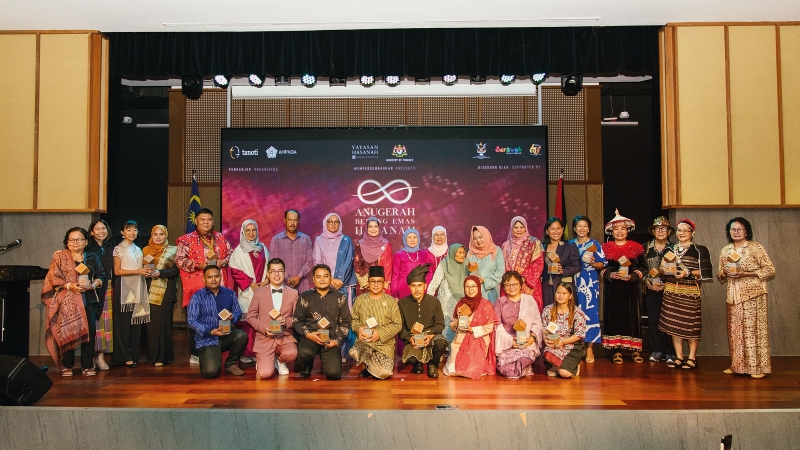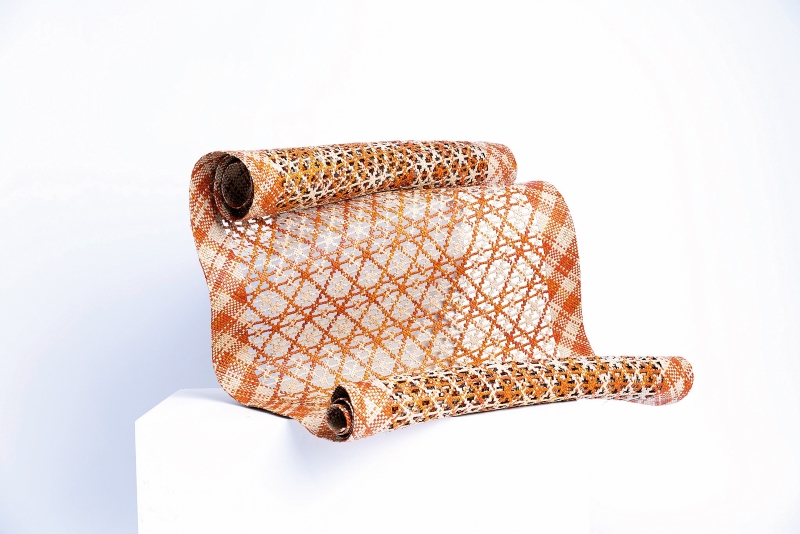
Ngot receiving her award from Shahira (All photos: Yayasan Hasanah)
A lot of young people would be delighted to engage in a conversation on fashion. Going online and browsing through portals, admiring favourite celebrities who more often than not influence their sense of style, have become part of their daily activities. As such, they may be familiar with essential contemporary fabrics such as cotton, linen, silk, chiffon and denim.
Unfortunately, the same cannot be said of our heritage textiles and crafts. Even the older generation is only acquainted with the more popular materials such as batik, songket and tenun. It is a worrying fact indeed. This realisation impelled Yayasan Hasanah (Hasanah), the impact-based foundation of sovereign wealth fund Khazanah Nasional Bhd, to take significant measures to tackle the problem.
“We are marked by a cultural crisis in that arts, cultural and heritage practitioners are growing older. We find ourselves at risk of losing not just our tangible and intangible heritage, but also a part of our very identity. Many textile traditions, legacies, techniques and applications are on the verge of extinction. Some of our Adiguru Kraf (individuals recognised by the government as master craftsmen) are very old, yet they don’t have perantis (apprentices),” Hasanah trustee and managing director Datuk Shahira Ahmed Bazari said at the press conference for the inaugural Hasanah Gold Threads Awards in September.
“There are so many beautiful heritage textiles that we are not aware of, such as ikat, kelingkan and keringkam. They are underappreciated, but so much knowledge and craftsmanship are required to produce an item. We are hoping this initiative will start conversations and spread awareness of them.”
Presented by Hasanah and the Ministry of Finance in collaboration with Tanoti and the Asean Handicraft Promotion & Development Association (AHPADA), the ceremony was held at the Borneo Cultures Museum in Kuching.
photo_6.jpg

As co-founder of Tanoti, an organisation that works with more than 500 artisans from 25 villages across Sarawak, and producer of the Hasanah Gold Threads Awards, Jacqueline Fong understands very well the hard labour that goes into producing heritage textiles.
“For a weaver, [the journey] is very lonely. She works on a piece of cloth day and night, week after week, month after month. But nobody gives her feedback, support or encouragement. Her children are running around while the husband is asking her to feed him. It’s a very lonely existence,” Fong said.
“We want to highlight the people who make crafts but are hardly acknowledged until they complete their work. And when they finish making something, they have to figure out how to sell it. So, it’s very difficult for them.”
Tanoti’s strong and constant relationship with Hasanah was established in 2020. Fong presented the idea to the foundation, knowing the latter has an arts and heritage pillar that focuses on preserving and conserving textiles.
“The awards are meant to honour those who put in the real work in producing beautiful textiles, pushing the boundaries with their own techniques, materials and designs, as well as those committed to their disciplines. It is intended to keep our [fabrics] alive. We want another generation to be able to enjoy them, whether they are wearing it, looking at it as art or making a living from it. If the current generation does not get to embrace this, we hope the legacy will continue for the next.”
plaiting_-_best_innovative_-_ranee_1.jpg

In this first instalment, there were six categories of competition — each with two primary awards, Best Traditional and Best Innovative — Beadwork, Drawing and Stamping, Embroidery and Embellishment, Ikat, Plaiting and Supplementary Weft. Winners got a cash prize of RM25,000 each, while commendable efforts received Special Mention Awards of RM10,000 cash prize.
Elaine Chan, secretary-general of AHPADA, cited excellence, quality, fine production and authenticity as among the criteria for selection. An esteemed panel of judges meticulously evaluated a total of 168 submissions from artisans in their twenties to nineties across the country.
Eighteen makers, including Shah Nor Ramin Mohamad, Davis Anak Mering, Juliana Anak Embrose, Bangie Anak Embol and The Ranee Sdn Bhd, were honoured.
The winner of the Plaiting award (Best Traditional category), Ngot Bi, drew attention for her passion, outstanding skills and undying love for anyaman (weaving). At 91, the Sarawakian Adiguru Kraf from Samarahan is still putting her back into the craft. She created an intricate open lattice plaited pandanus mat with turtle motif, which symbolises longevity.
“I started menganyam when I was young. I kept doing it until I became good. A while ago, there were about 50 of us who learnt the craft but I was the only one doing it in the end because the others could not live on the measly pay,” she said.
plaiting_-_best_traditional_-_ngot_binti_bi_1.jpg

The work involved is not easy as it requires a lot of physical effort. As Ngot herself acknowledged, “Saya dah tua, kadang-kadang rasa sakit. Tapi sebab hati suka, tiada rasa sakit. Teruslah menganyam, nanti kejap saja siap. (I am already old, sometimes I feel pain. But because I enjoy it, the pain does not hold me back. I just keep on weaving, and it’ll be quickly finished).”
Hasanah has developed programmes especially for the younger generation to garner interest in conserving precious textiles that are special to the country. One initiative is The Silver Lining Project in Kelantan, a talent development scheme whereby an adiguru teaches crafts such as telepuk, songket, kelingkan and keringkam to a class of 20 to 30 people.
The foundation also works with The Brooke Trust in Sarawak, providing comprehensive training in keringkam embroidery to students of Sekolah Henry Gurney Puncak Borneo.
Meanwhile, another recent project focuses on obtaining copyright for national emblems such as Bunga Labu, Bunga Terong Pipit, Pokok Kiambang and Bunga Asam Gelugor.
“When we learn about all the motifs that are unique to us, we have to copyright them. Malaysia is still behind when it comes to legitimising our assets,” said Shahira.
“Recently, more than 13 motifs have been copyrighted and new patterns have been created to attract the youth. These are some of the work happening behind the scenes. Preserving our rich heritage is a continuous effort and hopefully, we are able to drive demand for locally produced textiles and push the industry forward.”
This article first appeared on Nov 6, 2023 in The Edge Malaysia.


